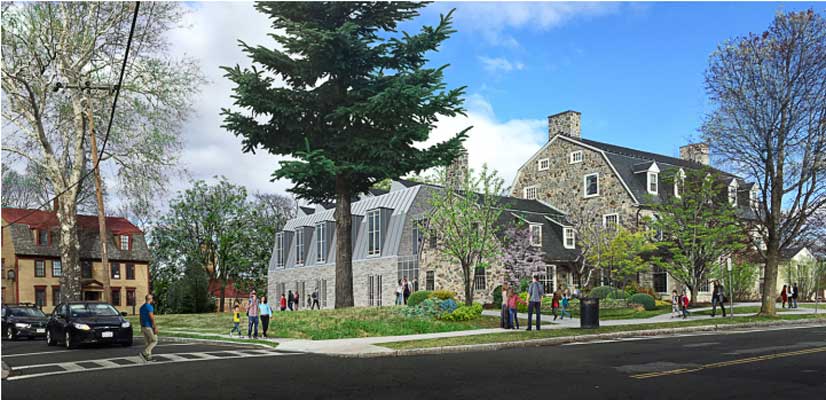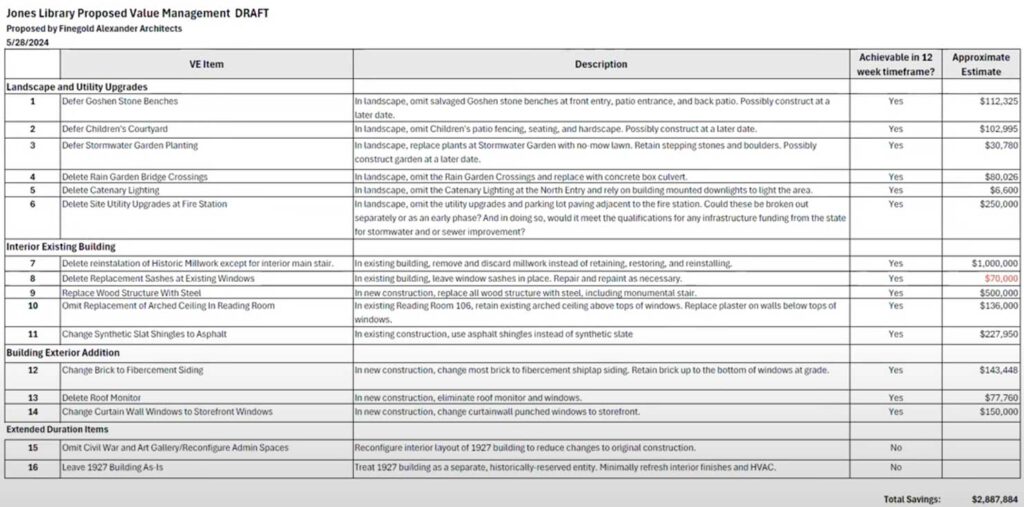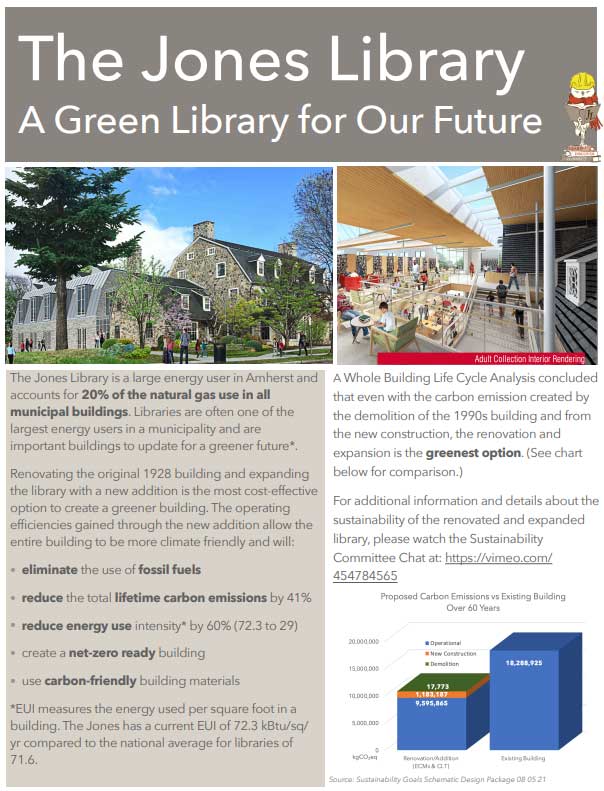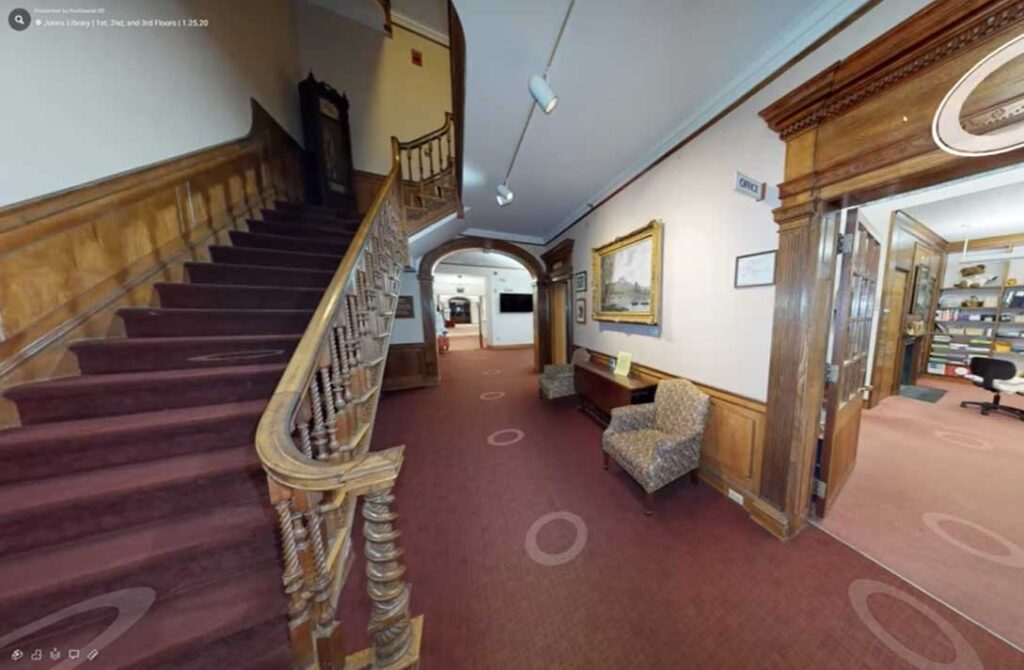Designers Propose Cuts to Library Sustainability and Historic Preservation

Green Building Features May be Eliminated
After rejecting a lone construction bid that would have put the cost of the Jones Library renovation-expansion $7.2 million higher than the Town Council’s $46.1 million appropriation for it, Town Manager Paul Bockelman has admitted that the options for moving the project forward are limited.
Finegold Alexander Architects (FAA) have suggested that rebidding the project in the fall may succeed in attracting more competitive general contractor bids. At the request of the Town, FAA has prepared a “value management” set of design changes aimed at lowering construction costs by $2.9 million. This compilation of potential modifications comes after an earlier value management exercise accepted $1.9 million worth of feature reductions in the over-budget design.
A close look at the FAA list reveals the possible elimination of features that may be dear to the hearts of project proponents and donors (which technically includes all Amherst property taxpayers).

As a privately owned building, the Jones Library is exempt from Amherst’s Zero Energy Town Building Bylaw and its renovation plan has never included full renewable energy operation. Nonetheless, promoters have long touted the project’s sustainability features. At a March 2022 public forum, Trustee President Austin Sarat described the future library as “one of the greenest buildings, if not the greenest building in Amherst.”
Sarat then ran through a list of features that would contribute to the library’s greenness. “The building is going to be more insulated. The building is going to have many solar panels. The building is going to have a lot of windows which will allow sunlight and warmth to come in. Right now, we have an HVAC system in our building which is failing, so the building will be adequately cooled. The way in which the building is being constructed will not be using steel beams. We’re using cross-laminated timber that’s designed to minimize the carbon output during the process of construction.”
To make the project affordable, FAA has proposed putting most of these sustainability features on the chopping block. Gone would be solar panels, new double-insulated windows, and cross-laminated timber construction. Also suggested for elimination is a roof “light monitor” that would mimic the effect of the current library atrium in letting in natural light.
At the May 28 Jones Library Building Committee (JLBC) meeting, Trustee Treasurer Robert Pam attempted to describe a potential energy-efficient air source heat pump system that might be placed in the rear of the building if plans for a 15,000 sq. ft. addition are abandoned, but Chair Sarat cut him off, ruling his comment as out of scope. Design plans for such an HVAC system as well as for an updated fire suppression system have already been developed and are owned by the town, Pam has argued.
The FAA list also includes replacing larger curtain wall punched windows on the new building’s north side with storefront-style windows.
FAA principal Ellen Anselone has estimated that fees for redesign work to document the value management changes might be $800,000. The elimination of green materials could necessitate re-running a for-fee TALLY assessment that quantifies embodied carbon in the new construction, said FAA’s Josephine Penta.
In addition to possible lost pledges from donors who contributed to the project based on its sustainability promises, questions arise concerning the Jones Library’s continued eligibility to receive a $1.1 million federal earmark for specific energy efficiency measures.

Cuts to Preserving Library’s Historic Character Proposed
As a recognized historic property represented in the Massachusetts and National Register of Historic Places, the historic character of the Jones Library is protected by local, state and national regulations.
The significant historic assets incorporated in the original 1928 building have been catalogued in a Historic Structures Report commissioned by the town in 2021.
Protection at the local level is guaranteed by a Preservation Restriction Agreement signed between the Town of Amherst and the Library Trustees as a result of the library accepting CPA funds for historic rehabilitation work. In particular, the document states that the Library “shall not make any changes to the exterior of the Building, including additions to and the alteration, partial removal, construction, remodeling, or other physical or structural change to the facades of the Building, and any change in design, material or color thereof” without prior express written permission by the town.
FAA’s cost reduction proposals include abandoning the planned reinstallation of much original millwork crafted from exotic woods, opting instead to “remove and discard millwork instead of retaining, restoring and reinstalling.” Only the staircase near the main entry would be retained.

FAA has estimated that eliminating historic millwork would save $1 million. Anselone explained that reinstallation is complicated by the presence of asbestos in the plaster throughout the original building.
“A specialized abatement person [would be responsible for] removing this, cleaning the asbestos off, tagging it with where it goes, and then storing it in the proper climate. Then when the new gypsum is put in, they would then have to fit all of this back in place, and that is tricky because you know the walls currently may be not be quite straight, and then the new walls go on and they’re straight and so it doesn’t always match up so there’s a lot of work,” she said.
Anselone described two options for replacing the millwork. An attempt could be made to match the original pieces, but this would likely be expensive and require extensive architectural drawing. The alternative is to replace it with simple trim like “what you’d see in a house.”
Another proposed hit to historic preservation would be abandoning the planned synthetic slate roof and going with asphalt shingles which have a shorter lifespan. Facilities Supervisor George Hicks-Richards wondered if this would be acceptable to the Amherst Historic Commission.
Also affecting the building’s exterior would be the proposed replacement of brick walls with fiber cement siding that would require periodic painting.
Trustee Pam cautioned that adopting these cost reductions would likely disqualify the library from receiving $2 million in state historic tax credits that the Capital Campaign has been counting on.
Also in jeopardy could be a $1 million National Endowment of the Humanities grant from the federal government that requires a Section 106 review of the project’s compliance with the National Historic Preservation Act.
Landscaping and Furnishings May Be Dropped
FAA proposed delaying several landscaping and utility upgrades to lower costs. When this work would be completed and who would pay for it was not fleshed out.
Other savings discussed by the JLBC consist of items outside the scope of design, such as furniture, fixtures and equipment (FFE). Library Director Sharon Sharry acknowledged that purchase of a $400,000 automatic book sorter to be placed in the historic director’s office is no longer planned. “Staff have already accepted the fact that the book sorter is gone,” she said. “It could come another time,” she added.
FAA’s Anselone stated that the window for completing value management redesign in time to bid out in September is 12 weeks. If the Massachusetts Board of Library Commissioners agrees to extending the grant-imposed deadline for starting construction at their June 6 meeting, “the clock starts ticking on June 10,” she said.

What the trustees are planning is criminal! The only positive element is the dumping of the book sorter which may preserve first library director, Charles Green’s original office!
Loosing two million dollars will cost us $800,000 in architect fees and an equal amount or more in tax credits and possible donations? Ludicrous, if I’m reading the details correctly.
In middle school some of my less savory friends used to play a cafeteria/library game, just to see if the “marks” were paying attention.
They’d ask the mark “Can ya gimme two dimes for a nickel?”
Often the mark would fork over the dimes, only to realize what had gone down after it was too late.
Now change the cafeteria to a library, multiply the stakes of that game by about 40 million and you’ve got the latest game in town!
Pay attention, Amherst residents!! Don’t be a mark!!!